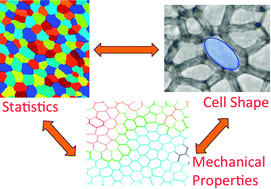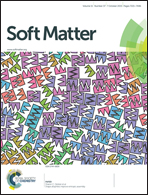Cell shapes and patterns as quantitative indicators of tissue stress in the plant epidermis†
Abstract
In a confluent, single-cell tissue layer, we show that cell shapes and statistics correlate directly with the tissue's mechanical properties, described by an energy functional with generic interfacial terms only. Upon increasing the cohesive component of the model, we observe a clear transition from a tense state with isotropic cells to a relaxed state with anisotropic cells. Signatures of the transition are present in the interfacial mechanics, the domain geometry, and the domain statistics, thus linking all three fields of study. This transition persists for all cell size distributions, but its exact position is crucially dependent on fluctuations in the parameter values of the functional (quenched disorder). The magnitude of fluctuations can be matched to the observed shape distribution of cells, so that visual observation of cell shapes and statistics provides information about the mechanical state of the tissue. Comparing with experimental data from the Cucumis epidermis, we find that the system is located right at the transition, allowing the tissue to relieve most of the local stress while maintaining integrity.


 Please wait while we load your content...
Please wait while we load your content...